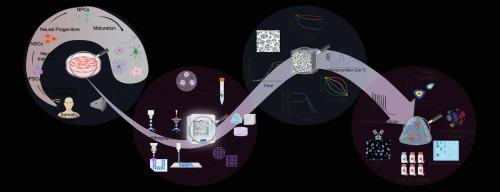Recent advances in 3D bioprinted neural models: A systematic review on the applications to drug discovery
IF 17.6
1区 医学
Q1 PHARMACOLOGY & PHARMACY
引用次数: 0
Abstract
The design of neural tissue models with architectural and biochemical relevance to native tissues opens the way for the fundamental study and development of therapies for many disorders with limited treatment options. Here, we systematically review the most recent literature on 3D bioprinted neural models, including their potential for use in drug screening. Neural tissues that model the central nervous system (CNS) from the relevant literature are reviewed with comprehensive summaries of each study, and discussion of the model types, bioinks and additives, cell types used, bioprinted construct shapes and culture time, and the characterization methods used. In this review, we accentuate the lack of standardization among characterization methods to analyze the functionality (including chemical, metabolic and other pathways) and mechanical relevance of the 3D bioprinted constructs, and discuss this as a critical area for future exploration. These gaps must be addressed for this technology to be applied for effective drug screening applications, despite its enormous potential for rapid and efficient drug screening. The future of biomimetic, 3D printed neural tissues is promising and evaluation of the in vivo relevance on multiple levels should be sought to adequately compare model performance and develop viable treatment options for neurodegenerative diseases, or other conditions that affect the CNS.


生物3D打印神经模型的最新进展:在药物发现中的应用综述
神经组织模型的设计与天然组织的结构和生化相关,为许多治疗选择有限的疾病的基础研究和治疗开发开辟了道路。在这里,我们系统地回顾了3D生物打印神经模型的最新文献,包括它们在药物筛选中的潜在应用。从相关文献中回顾了模拟中枢神经系统(CNS)的神经组织,对每项研究进行了全面的总结,并讨论了模型类型,生物墨水和添加剂,使用的细胞类型,生物打印构建体形状和培养时间,以及使用的表征方法。在这篇综述中,我们强调在分析3D生物打印结构的功能(包括化学、代谢和其他途径)和力学相关性的表征方法中缺乏标准化,并将其作为未来探索的关键领域进行讨论。尽管这项技术在快速和有效的药物筛选方面具有巨大潜力,但必须解决这些差距,以便将其应用于有效的药物筛选应用。仿生、3D打印神经组织的未来是有希望的,应该寻求在多个层面上的体内相关性评估,以充分比较模型的性能,并为神经退行性疾病或其他影响中枢神经系统的疾病开发可行的治疗方案。
本文章由计算机程序翻译,如有差异,请以英文原文为准。
求助全文
约1分钟内获得全文
求助全文
来源期刊
CiteScore
28.10
自引率
5.00%
发文量
294
审稿时长
15.1 weeks
期刊介绍:
The aim of the Journal is to provide a forum for the critical analysis of advanced drug and gene delivery systems and their applications in human and veterinary medicine. The Journal has a broad scope, covering the key issues for effective drug and gene delivery, from administration to site-specific delivery.
In general, the Journal publishes review articles in a Theme Issue format. Each Theme Issue provides a comprehensive and critical examination of current and emerging research on the design and development of advanced drug and gene delivery systems and their application to experimental and clinical therapeutics. The goal is to illustrate the pivotal role of a multidisciplinary approach to modern drug delivery, encompassing the application of sound biological and physicochemical principles to the engineering of drug delivery systems to meet the therapeutic need at hand. Importantly the Editorial Team of ADDR asks that the authors effectively window the extensive volume of literature, pick the important contributions and explain their importance, produce a forward looking identification of the challenges facing the field and produce a Conclusions section with expert recommendations to address the issues.

 求助内容:
求助内容: 应助结果提醒方式:
应助结果提醒方式:


